Norwich Cathedral
We spent an absolutely beautiful day in Norwich. The weather couldn't have been better: Danny wore short-sleeves almost all day. We've split our day into two posts since we took so many pictures. This first post tells the story of our tour of Norwich Cathedral.
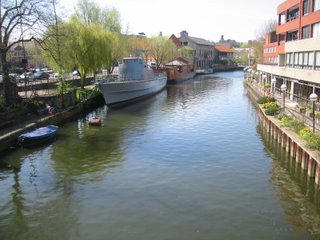
We arrived on the train from Cambridge at midmorning. Here is the river Wensum that runs around the city of Norwich. The train station is off to the left of this picture.

Look at how beautiful those willows are!

Here is the Water Gate at Pull's Ferry.

This picture was taken from the riverwalk along the Wensum. There are two primary schools near the Cathedral; neither one is considered a Cathedral school.

We approached from the Cathedral close towards the South Transept. The door on the lower left of the photo is the Dark Entry to the Cathedral cloister.

The ceiling of the cloister hall was filled with bosses (carved and painted wooden medallions) depicting the narrative of the Book of the Apocalypse.

Here's the tower as seen from the cloisters. Isn't that sky a gorgeous blue?
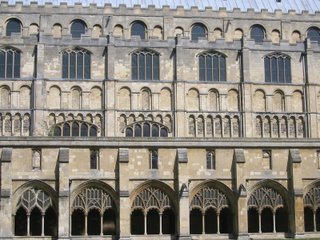
Here is the side of the Cathedral, viewed from the center of the cloister.

Here's another beautiful view of the cloister. Norwich Cathedral has the largest medieval cloister in England.

Here is one of many ceiling bosses you will see in this blog. "A throne was there in heaven, and on the throne sat one whose appearance sparkled like jasper and carnelian. Around the throne was a halo as brilliant as an emerald. Surrounding the throne I saw twenty-four other thrones on which twenty-four elders sat, dressed in white garments and with gold crowns on their heads." (Rev 4: 2-4)

And another one found in the cloister hall. "Then war broke out in heaven; Michael and his angels battled against the dragon. The dragon and its angels fought back." (Rev 12:7)

In this picture you can see the labrynth in the center of the cloister grounds. It was built in 2002 to commemorate the Golden Jubilee of HM Queen Elizabeth II. We enjoyed walking it.

Here is another ceiling boss found in the cloister.

This spectacular structure is the lintel atop the Prior's Door, the entry to the Cathedral from the cloister. It dates to about 1300 and shows Christ in the center flanked by angels and saints. On the far right is Moses holding the Ten Commandments.

This beautiful boss shows Christ crucified with His Mother on the left and Mary Magdalene on his right.
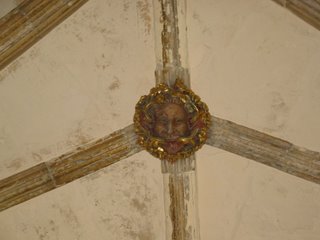
Here is one of a number Green Man bosses in the cloister halls. Green Man images are popular throughout England.

We absolutely loved this boss showing someone climbing away from a demon. "They were told not to harm the grass of the earth or any plant or any tree, but only those people who did not have the seal of God on their foreheads. They were not allowed to kill them but only to torment them for five months; the torment they inflicted was like that of a scorpion when it stings a person." (Rev 9:4-5)

This picture is of the buttress tower at the south-east corner of the Cathedral.

The inside of the Cathedral was as striking as the exterior. Here near the West entrance is a 'peace globe.'

Here is the Cathedral nave. Again, the interior was very bright, and the fan-vaulting of the ceiling was accented by ceiling bosses (a total of 1106 ceiling bosses throughout the Cathedral). The nave bosses were all of New Testament stories and characters.
 This is the West Window. It has an incredible story: It was completed in 1854, but in the 1870s, followers of Pugin (the man who worked on designing the Westminster Palaces) disapproved of the vivid colors, so a dark stain was applied to mute the colors. In 1995, during a restoration project, it was noticed that the original colors were much brighter. The stain was then removed, showing the original colored glass you see here.
This is the West Window. It has an incredible story: It was completed in 1854, but in the 1870s, followers of Pugin (the man who worked on designing the Westminster Palaces) disapproved of the vivid colors, so a dark stain was applied to mute the colors. In 1995, during a restoration project, it was noticed that the original colors were much brighter. The stain was then removed, showing the original colored glass you see here.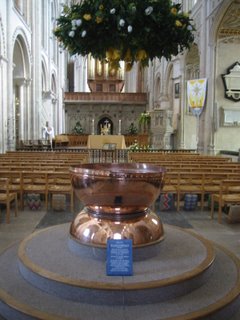
This baptismal font is made of copper; it was once a vat for boiling chocolate from Norwich's Caley chocolate factory! The vat was cut in half, one half used as the stand, the other as the bowl.
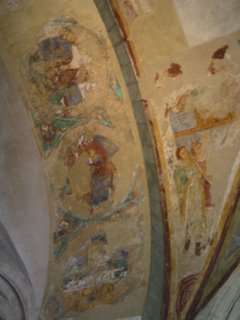
This fragment of painting is all that is left of the original wall painting in the Cathedral.

The mother pelican was thought to nurture her young by piercing her breast with her beak and feeding them her own blood. This made for an obvious symbol of self-sacrifice, applied to Jesus Christ, Who redeems the world through the voluntary outpouring of His Blood. A connection to the Eucharist is likewise easy to make: Christ feeding His faithful with His own Body and Blood. The baby pelicans are seen along the bottom. This pelican is located on the edge of a choir stall.
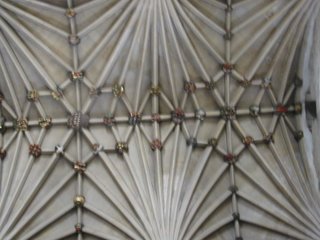 This is the ceiling of the choir. The bosses here tell the Old Testament story of creation as well as depicting patriarchs and prophets.
This is the ceiling of the choir. The bosses here tell the Old Testament story of creation as well as depicting patriarchs and prophets.
This picture was taken from the High Altar, looking down into the choir. The organ is actually not that large (in size). However, it sports 6655 pipes!

This beautiful window shows Catherine of Alexandria, whose cult was quite popular in the the late middle ages in England.

You can see in this picture of the high altar and windows just how bright the Cathedral is.

This wall sculpture shows St. Felix, who brought Christianity to East Anglia, and served as its first bishop.
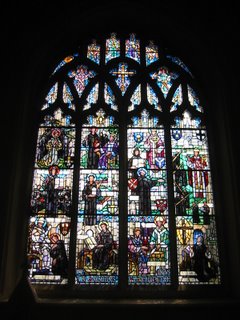
The Cathedral was first a Benedictine Monastery. This beautiful window is aptly called the 'Benedictine Window.' See below for some close-ups.
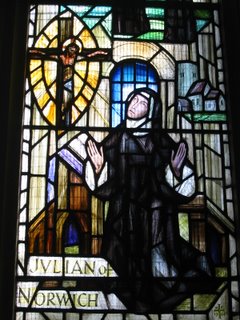
Here is a close-up of St. Julian of Norwich. You'll learn more about her in our next post.
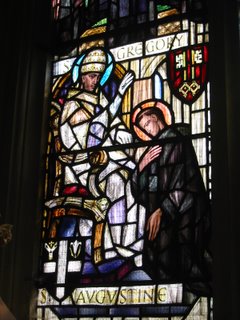
This window depicts St. Pope Gregory the Great sending St. Augustine of Canterbury to convert Britain to Christianity.
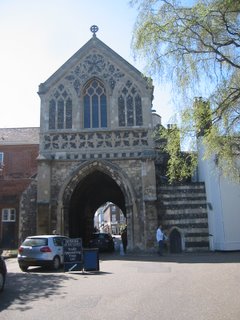
As we were leaving the Cathedral grounds, we passed by this ancient gate, the Ethelbert Gate.

A lovely parting shot of the Cathedral.
 This is the West Gate. The large window you see here is the beautiful stained-glass window whose true colors were liberated in the 1995 restoration.
This is the West Gate. The large window you see here is the beautiful stained-glass window whose true colors were liberated in the 1995 restoration.Our tour of the Cathedral took nearly two hours! We had lunch at the Cathedral Refectory before moving on to our next stop: Norwich Castle.

0 Comments:
Post a Comment
<< Home